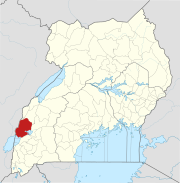Kilembe Mines
Kilembe Mines is a copper and cobalt mine in Uganda, the third-largest economy in the East African Community.[1]
Location
The mine is located in Kilembe, a suburb of the town of Kasese, in the foothills of the Rwenzori Mountains in the Western Region of Uganda The mine is approximately 380 kilometres (236 mi), by road, west of Kampala, the country's capital and largest city.[2] The coordinates of Kilembe Mines are:0°12'30.0"N, 30°00'25.0"E (Latitude:0.208333; Longitude:30.006944).[3]
Overview
Kilembe Mines is Uganda's largest copper mine, with estimated deposits of copper in excess of 4,000,000 tonnes and an undetermined amount of cobalt ore. In addition, there approximately 2,800 acres (1,100 ha), of unexplored acreage at the site.[4]
History
In July 1950, two Canadian mining companies, Frosbisher Limited and Ventures Limited, formed a joint venture, named Kilembe Mines Limited (KML), whose objective was to mine copper from under the Rwenzori Mountains near Kasese.[5] KML built and operated a copper smelter in Jinja and maintained offices in Kampala, the country's capital. Other assets include a housing estate for staff in Kasese and the 5MW Mubuku I Power Station in the Rwenzori Mountains.[6]
In 1962, KML was acquired by Falconbridge of Africa, who sold it to the Government of Uganda in 1975. Copper extraction ceased in 1982 due to dilapidated equipment, high inflation and insecurity.[5]
In 2013, after nearly 30 years of dormancy and after several failed attempts to privatize the mine, a consortium led by Tibet-Hima Mining Company Limited, won the competitive bid to manage, rehabilitate and operate Kilembe Mines Limited for 25 years from 2013 until 2038. In exchange for those rights, the consortium paid a cash down payment of US$4.3 million and is expected to make an annual payment of US$1 million until the end of the concession. Also, the consortium will invest US$135 into rehabilitating and improving the mine and will increase the capacity of Mubuku I Power Station to 12MW. In addition to the cash payments above, the Ugandan government will receive royalties on the minerals extracted as well as taxes from Kilembe Mines Limited business operations.[5]
Recent events
As of June 2015[update], the managers at Kilembe have set September 2015 to resume copper extraction. The mine will be revived in stages. A copper smelter will be constructed at Kilembe to process the ore and produce 99.9% pure copper for export. When fully operational, the mine will employ 4,000 full-time workers.[7]
See also
References
- ^ Aanyu, Rehema (22 August 2013). "Exploring My Uganda: The Kilembe Mines". New Vision (Kampala). Retrieved 3 June 2015.
- ^ "Road Distance Between Kampala And Kilembe With Interactive Map". Globefeed.com. Retrieved 3 June 2015.
- ^ Google, . "Location of Kilembe Mines At Google Maps". Google Maps. Retrieved 3 June 2015.
{{cite web}}:|first=has numeric name (help);|last=has generic name (help) - ^ Monitor Reporter, . (4 November 2012). "Government To Sell Kilembe Mines". Daily Monitor (Kampala). Retrieved 3 June 2015.
{{cite web}}:|first=has numeric name (help) - ^ a b c Kasita, Ibrahim (5 July 2013). "Chinese Take Over Kilembe Mines". New Vision (Kampala). Retrieved 3 June 2015.
- ^ Sseppuya, Mikaili (5 July 2007). "River Mubuku Plant To Avail 10MW". New Vision (Kampala). Retrieved 3 June 2015.
- ^ Musoke, Ronald (31 May 2015). "Imminent Copper Dollars". The Independent (Uganda). Retrieved 3 June 2015.

